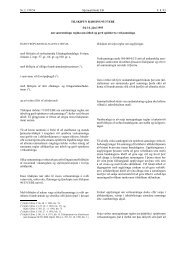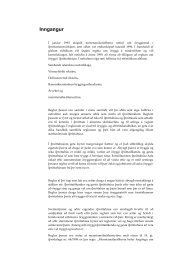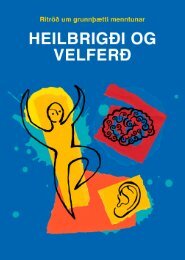Arts and Cultural Education in Iceland : Professor Anne Bamford
Arts and Cultural Education in Iceland : Professor Anne Bamford
Arts and Cultural Education in Iceland : Professor Anne Bamford
You also want an ePaper? Increase the reach of your titles
YUMPU automatically turns print PDFs into web optimized ePapers that Google loves.
The curriculum is flexible <strong>and</strong> schools are encouraged to be proactive. Despite this apparent<br />
freedom, <strong>in</strong> the schools visited throughout Icel<strong>and</strong> there appears to be remarkable similarity <strong>in</strong><br />
pedagogical practices <strong>and</strong> the way learn<strong>in</strong>g is organised. The most likely explanation for the<br />
similarity is probably the shared teacher education tra<strong>in</strong><strong>in</strong>g. Although more fully discussed later<br />
<strong>in</strong> the report, the general view was that teacher education did not encourage divergence <strong>in</strong> the<br />
curriculum <strong>and</strong> tended to promote the status quo, as this comment suggests:<br />
The teachers need to be taught to teach creatively. All teachers need some arts <strong>and</strong> cultural education. It needs<br />
to be a focus throughout the school system.<br />
New music syllabuses have been <strong>in</strong>troduced over the past few years. They are based on the<br />
classical system. These new music documents were not pilot tested <strong>and</strong> they have not been<br />
reviewed. Once aga<strong>in</strong>, with this new syllabus there appears to be a disjuncture between the<br />
flexible philosophy that underp<strong>in</strong>s the document <strong>and</strong> the feel<strong>in</strong>g ‘<strong>in</strong> the field’ that such<br />
documents constra<strong>in</strong> <strong>and</strong> dictate teach<strong>in</strong>g <strong>and</strong> learn<strong>in</strong>g choices. While schools argue that the<br />
way they organise th<strong>in</strong>gs is bound by a number of laws, this is disputed by those responsible for<br />
the syllabus who say, “It is the music schools that impose their own rules <strong>and</strong> restrictions. There<br />
are no laws that are <strong>in</strong> effect other than about f<strong>in</strong>ancial support. The syllabus is published <strong>and</strong> it<br />
is a guidel<strong>in</strong>e <strong>and</strong> no one is obliged to use it. It is a big misunderst<strong>and</strong><strong>in</strong>g <strong>in</strong> the field.” As can be<br />
seen <strong>in</strong> Figure 1.5.2 the music curriculum is seen to be quite useful <strong>in</strong> establish<strong>in</strong>g objectives for<br />
music but of less use for educational content or methods, where less than 50% of respondents<br />
found it either useful or very useful. 10<br />
Figure 1.5.2: How useful is the National Curriculum Guide (music)<br />
Figure 1.5.3 shows the response to the usefulness of the curriculum <strong>in</strong> the compulsory<br />
school. In this <strong>in</strong>stance, educational objectives was seen to be most useful, while teach<strong>in</strong>g<br />
methods <strong>and</strong> assessment were considered to be the least useful aspect. Despite this pattern,<br />
there was general acceptance fo the value of curriculum with less than 1% of respondents<br />
feel<strong>in</strong>g that it was ‘useless’.<br />
10 The music syllabus has been <strong>in</strong> the works for more than 17 years <strong>and</strong> is not completed yet. The General<br />
Section was published 2000. Eight separate documents have s<strong>in</strong>ce been published for different <strong>in</strong>struments (see<br />
). The last syllabus, the one for jazz <strong>and</strong> rock<br />
music, is pend<strong>in</strong>g later this year. Almost all music schools operate accord<strong>in</strong>g to exist<strong>in</strong>g law (nr. 75/1985) on f<strong>in</strong>ancial<br />
support for music schools. Chapter 1, article 1 of this law states that the law applies only to schools that teach "...<br />
accord<strong>in</strong>g to an official curriculum published by the M<strong>in</strong>istry of <strong>Education</strong>...". Furthermore, as can be seen at the<br />
beg<strong>in</strong>n<strong>in</strong>g of the general section (available <strong>in</strong> English translation through the URL above), the curriculum is quite<br />
extensive as to the operation of music schools. Increas<strong>in</strong>gly, service contracts between municipalities <strong>and</strong> music<br />
schools m<strong>and</strong>ate that music schools operate accord<strong>in</strong>g to the official curricula. Accord<strong>in</strong>g to the current survey about<br />
80% of music schools use the service of the Music Schools' Exam<strong>in</strong>ations Board <strong>and</strong> thus, operate accord<strong>in</strong>g to the<br />
official curriculum.<br />
20



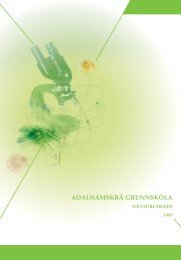
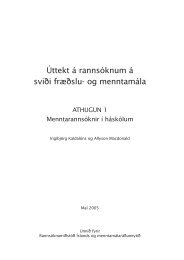

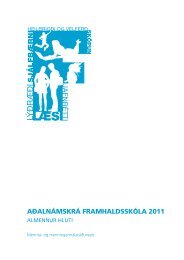
![Aðalnámskrá tónlistarskóla : rytmÃsk tónlist [Eingöngu á rafrænu formi]](https://img.yumpu.com/50843672/1/184x260/aaalnamskra-tanlistarskala-rytma-sk-tanlist-eingangu-a-rafranu-formi.jpg?quality=85)



